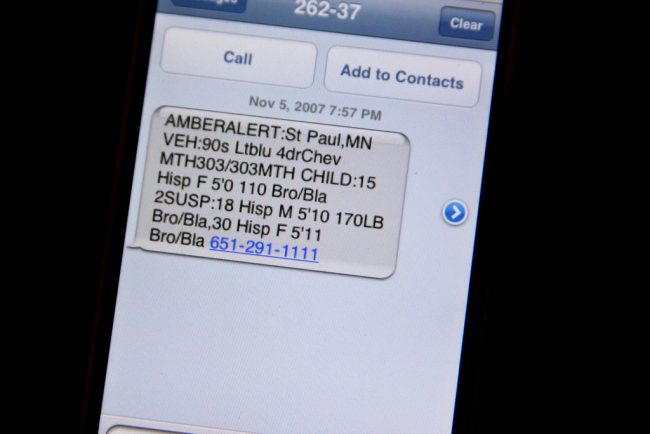|
Getting your Trinity Audio player ready...
|

When a child, 17 years of age or younger, is reported missing or abducted police and the Federal Communications Commission (FCC) air an AMBER alert (AA), more commonly called America’s Missing Broadcast Emergency Response Plan.
The National Crime Information Center (NCIC) system issues pocket cards (available to print) with the following criteria must be met for an AA to be issued:
-
- “Law enforcement officials have a reasonable belief that an abduction has occurred.”
- “Law enforcement officials believe that the child is in imminent danger of serious bodily injury or death.”
- “Enough descriptive information exists about the victim and the abductor for law enforcement to issue an AMBER Alert.”
- The child is 17 years old or younger.
- “The child’s name and other critical data elements—including the child abduction (CA) and AA flags—have been entered into the NCIC system.”
The public receives a notice of an AMBER Alert in one or more of these methods: local breaking news announcement, local broadcasting agency Emergency Alert System on either the television or radio, Twitter, Facebook, fliers, or through the Commercial Mobile Alert System on their cell phones.
The Wireless Emergency Alert program is brought to Americans from the Federal Emergency Management Agency. This agency “distributes authorized federal, state, local, and tribal government agencies.” In addition to AMBER Alerts, emergency texts include imminent threat, U.S. Presidental, and National Weather Service alerts.
To determine if a mobile device is alert capable, the National Center for Missing & Exploited Children recommends users go to www.ctia.org/wea. Once there, find the link for the service provider. Here users can determine if their device is compatible. When deciding to purchase a new phone, users can either go to the website or look for this symbol:

Some phones will activate the alerts automatically with a prompt notifying the users the system is set on their phone. If it does not or if a user wants to verify it is activated, go to the phone’s settings and in the search bar type in Emergency. Some phones will say “Emergency Tone.” Whichever comes up, select the option. Once opened a drop-down menu will open with settings choices: silent, vibrate, tone.
There are several factors in the emergency alert system to remember. The system uses a special carrier which is not “affected by congestion on voice or SMS text channels.” All alerts are sent out simultaneously to cell phones within range of towers in the area the where the alert was established. The system does not need to know the users’ phone numbers and it is not capable of tracking the phone’s location. Cell phone companies are not allowed to charge their customers fees for the emergency alert texts.
It is important to remember that alerts will not be received if the emergency tone is set to vibrate. Also, when a phone is set to vibrate, not ring, an audible signal will not be heard.
AMBER Alerts Origin
After 9-year-old Amber Hagerman was abducted and subsequently murdered in Texas, a young woman suggested using the Emergency Broadcast System to notify communities about cases missing and endangered children.
She followed up with a letter, which was used to create the first AMBER plan. In honor of the murdered child, the AMBER Alert system was established in 1996.
What About Vulnerable Adults/Seniors?
The policies of the AMBER Alert system were used when the Silver Alert program was established in the United States in September 2008. This plan is essential due to the rapidly aging population and the indicate the expectation of a corresponding increase of missing adults.
Silver Alerts are intended to notify communities about vulnerable adults who are missing. This includes cognitive impairments such as dementia, Alzheimer’s Disease, Traumatic Brain Injury (TMI), and developmentally challenged.
The Public’s Responsibility
When the audible alert comes across the airwaves it is intended for the average American in the area of concern. If a person listens to the announcement and makes a note of the event, they should be on top alert.
In the case of an AMBER Alert, keep a sharp eye out for the child. If a person suspects they have seen the child, they should immediately phone 911 and give clear details to the Emergency Police Dispatcher.
If a Silver Alert, watch out for the person in the notice and call 911.
In the case of a weather, imminent threat, or a presidential alert, make certain to check in with your neighbors and family members in the area. Update them if they have not heard the news. Basically, share the message.
Written by Cathy Milne
Sources:
U.S. Department of Justice: Recommended AMBER Alert Criteria
Federal Communications Commission: The AMBER Plan (America’s Missing Broadcast Emergency Response)
National Center for Missing & Exploited Children: AMBER ALERTS AND WIRELESS EMERGENCY ALERTS FAQ
Oxford University Press: Silver Alerts and the Problem of Missing Adults with Dementia
Featured Image Courtesy of Tomás Del Coro’s Flickr Page – Creative Commons License
Top Image Courtesy of Tony Webster’s Flickr Page – Creative Commons License
Inset Image Courtesy of National Center for Missing & Exploited Children – Used With Permission



